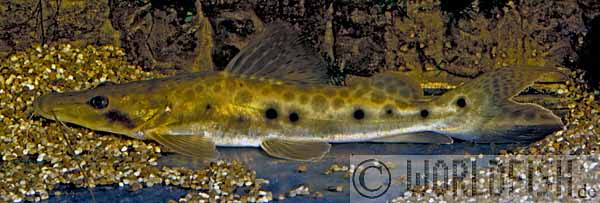Hemisorubim platyrhynchos
(Valenciennes, 1840)
|
Familie: Pimelodidae SynonymePlatystoma platyrhynchos Valenciennes, 1840
?Pimelodus coruscans] Lichtenstein, 1819
Lokale Bezeichnung |
 Hemisorubim platyrhynchos -- (C) Erwin Schraml |
Typen
Holotypus: MNHN 0000- 1203 .
Siehe: Eschmeyer, W.N., Fricke, R. & Van der Laan, R. (eds.) 2024. Catalog of Fishes electronic version
Typusfundort: ohne Typusfundort [Brasilien].
Etymologie
Platy (= flach); rhynchos (= Schnauze), bezieht sich auf den stark eingedrückten Kopf, der einem Entenschnabel ähnelt. (Übersetzt aus: The ETYFish Project)
Verbreitung
Einzugsgebiete des Amazonas, Maroni, Orinoco und Paraná (Argentinien, Bolivien, Brasilien, Kolumbien, Ecuador, Französisch-Guayana, Guyana, Paraguay, Peru, Surinam und Uruguay).
IUCN Status

EX Extinct (ausgestorben)
EW Extinct in the Wild (in der Natur ausgestorben)
CR Critically Endangered (vom Aussterben bedroht)EN Endangered (stark gefährdet)
VU Vulnerable (gefährdet)
NT Near Threatened (potenziell gefährdet)
LC Least Concern (nicht gefährdet)
RE Regionally Extinct (regional oder national ausgestorben)DD Data Deficient (ungenügende Datengrundlage)
NE Not Evaluated (nicht beurteilt)
Status: Stand 13.9.2022: NE Not Evaluated (nicht beurteilt)
Gefahren für diese Art: (nicht beurteilt)
Literatur
- Cuvier, G. & Valenciennes, A. 1840. Histoire naturelle des poissons. Tome quinzième. Suite du livre dix-septième. Siluroïdes. 15: i-xxxi + 1-540, Pls. 421-455. (BHL) Zitatseite [:27, !!, als Platystoma platyrhynchos]
- Lichtenstein, M.H.C. 1819. Ueber einige neue Arten von Fischen aus der Gattung Silurus. Zoologisches Magazin (Wiedemann), 1 (3): 57-63. Zitatseite [:58, !!, als Pimelodus coruscans]
- Kobayagawa, M. 1991. Faszination Welse. BEDE-Verlag, 160pp. Zitatseite [:49, Farbfoto ]
- Peters, W.C.H. 1877. Über die von Hrn. Dr. C. Sachs in Venezuela gesammelten Fische. Monatsberichte der Königlichen Preussischen Akademie der Wissenschaften zu Berlin, 1877: 469-473. Zitatseite [:470|Beschreibung ]
- Cope, E.D. 1878. Synopsis of the fishes of the Peruvian Amazon, obtained by Professor Orton during his expeditions of 1873 and 1877. Proceedings of the American Philosophical Society, 17 (101): 673-701. (BHL) Zitatseite [:674|gelistet ]
- Fowler, H.W. 1915. Notes on nematognathous fishes. Proceedings of the Academy of Natural Sciences of Philadelphia, 67: 203-243. (BHL) Zitatseite [:218|gelistet ]
- Fowler, H.W. 1941. A collection of fresh-water fishes obtained in eastern Brazil by Dr. Rodolpho von Ihering. Proceedings of the Academy of natural Sciences of Philadephia, 93: 123-199. (JSTOR) Zitatseite [:139|gelistet, Vorkommen ]
- Schultz, L.P. 1944. The catfishes of Venezuela, with descriptions of thirty-eight new forms. Proceedings of the United States National Museum, 94 (3172): 173-338, Pls. 1-14. (BHL) Zitatseite [:228|Synonyme ]
- Mees, G.F. 1974. The Auchenipteridae and Pimelodidae of Suriname (Pisces, Nematognathi). Zoologische Verhandelingen, 132: 3-248. Zitatseite [:118ff|Beschreibung, Synonyme, Vorkommen ]
- Burgess, W.E. 1989. An atlas of freshwater and marine catfishes. A preliminary survey of the Siluriformes. T.F.H. Publications, Neptune City, New Jersey, U.S.A. 1-784, Pls. 1-285. Zitatseite [:168, als Paradiplomystes coruscans; :282, als Hemisorubim platyrhynchos]
- Böhm, O. 1989. Einige ungewöhnliche Welse aus Südamerika. Das Aquarium, #237, (3): 145-147. Zitatseite [:145-147|Farbfoto, Verhalten ]
- Baensch, H.A. & Riehl, R. 1987. Aquarien Atlas, Band 2 (4. Auflage). Mergus-Verlag, Melle. Zitatseite [:552|Farbfoto, Synonyme ]
- Geisler, R. 1996. Erfolgreiche Zucht amazonischer Fische. Fischfarm "Projeto Pacu" bei Campo Grande (Brasilien). Die Aquarien- und Terrarienzeitschrift (DATZ), 49 (4): 258-262. Zitatseite [:262|gelistet, Fortpflanzung, /Farm ]
- Evers, H.-G. 1999. Finger weg von "Riesenbabies"! Von Welsen, die einen Meter groß werden können. Aquarium Heute, 17 (3): 363-365. Zitatseite [:365*|Farbfoto ]
- Arendt, K. 2000. Großwelse - Räuber vom Amazonas. Aquaristik Fachmagazin, #155, Okt./ Nov.: 2-12. Zitatseite [:9|Farbfoto, Vorkommen ]
- Fermon, Y. 2002. Guyane : Un environnement sous la loupe des scientifiques. Aquarium Magazine, 193, Juin 2002: 41-44. Zitatseite [:44|gelistet, Vorkommen ]
- Aquaristik Aktuell[2002/06:7|gelistet, Exportver ]
- Reis, R.E., Kullander, S.O. & Ferraris, Jr., C.J. 2003. Check List of the Freshwater Fishes of South and Central America. CLOFFSCA. EDIPUCRS, Porto Alegre. 729pp. Zitatseite [:436: Autoren: Lundberg & Littmann, als Hemisorubim platyrhynchos; :448, Autoren: Marceniuk & Ferraris über Probleme mit dem Typus von Pimelodus coruscans und mit der Platzierung in der Familie; als mögliches Synonym von Bagre bagre]
- Kailola, P.J. 2004. A phylogenetic exploration of the catfish family Ariidae (Otophysi: Siluriformes). The Beagle, Records of the Museums and Art Galleries of the Northern Territory, 20: 87-166. Zitatseite [:144, Pimelodus coruscans als Synonym von Hemisorubim platyrhynchos]
- Penha, J.M.F., Mateus, L.A.F. & Barbieri, G. 2004. Age and growth of the porthole shovelnose catfish (Hemisorubim platyrhynchos) in the Pantanal. Brazilan Journal of Biology, 64 (4): 833-840. (PDF) Zitatseite [:833-840|age&growth ]
- Marceniuk, A.P. & Menezes, N.A. 2007. Systematics of the family Ariidae (Ostariophysi, Siluriformes), with a redefinition of the genera. Zootaxa, 1416: 1-126. (PDF) Zitatseite [:31, Pimelodus coruscans als Species inquirenda]
- Litz, T.O. & Koerber, S. 2014. Check list of the freshwater fishes of Uruguay (CLOFF-UY). Ichthyological Contributions of PecesCriollos, 28: 1-40. Zitatseite [:18, Pimelodus coruscans als Synonym von Hemisorubim platyrhynchos oder Iheringichthys labrosus]
- Mirande, J.M. & Koerber, S. 2015. Checklist of the freshwater fishes of Argentina (CLOFFAR). Ichthyological Contributions of Peces Criollos, 36: 1-68. Zitatseite [:31, Pimelodus coruscans als fragliches Synonym von Hemisorubim platyrhynchos]
- Koerber, S., Vera-Alcaraz, H.S. & Reis, R.E. 2017. Checklist of the fishes of Paraguay (CLOFPY). Ichthyological Contributions of PecesCriollos, 53: 1-99. Zitatseite [:47, Pimelodus coruscans als fragliches Synonym von Hemisorubim platyrhynchos]
- Grant, S. 2021. Pims. Pimelodidae, Heptapteridae and Pseudopimelodidae. ATS-Aquashop, Neustadt am Rübenberge: 1-219. Zitatseite [:65, Pimelodus coruscans als fragliches Synonym von Hemisorubim platyrhynchos]
- Werner, U. 2022. Einige Welse und "Oddballs" aus dem Maroni. Die Aquarien- und Terrarienzeitschrift (DATZ), 75 (3): 54-62. Zitatseite [:56*, Farbfoto, Biotop, als Hemisorubim platyrhynchus]
- Avigliano, E., Pouilly, M., Silva, N. & Sánchez, S. 2023. High plasticity in short- and medium-scale movements in two catfish species from the Paraná Basin. Environmental Biology of Fishes, Published: 24 January 2023. (doi) Zitatseite